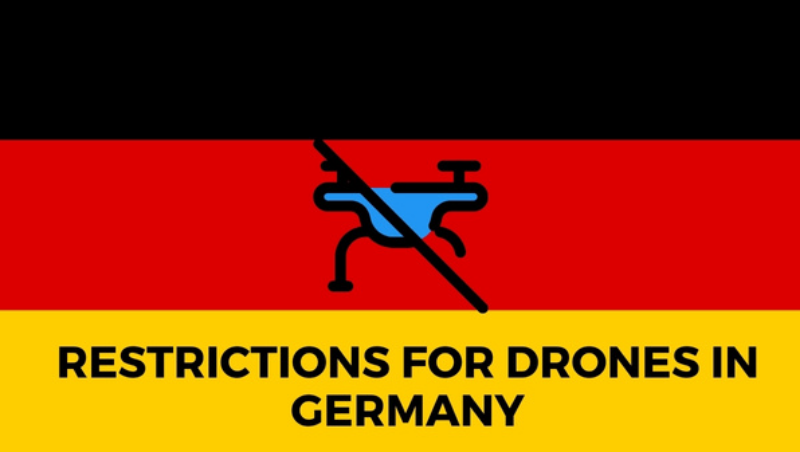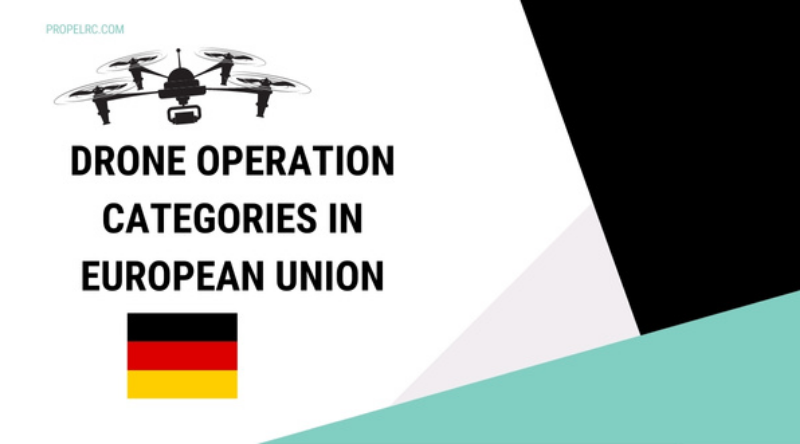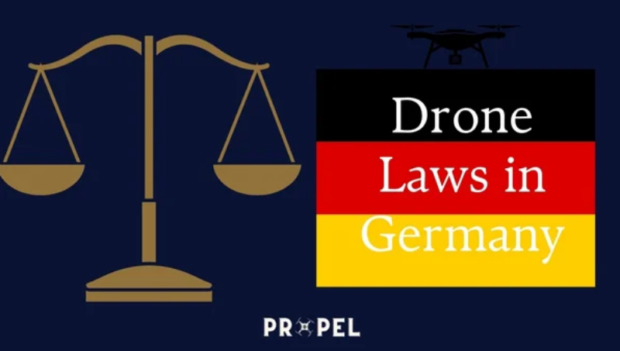In Germany, drones are quickly becoming integrated into the lives of everyday citizens. Mostly used for commercial purposes like aerial photography and surveying, drones in the country have the potential to greatly reduce the time and energy that would have been spent gathering an array of data from various manual processes.
With the increased use of drones, authorities in Germany now need to place adequate policies and regulations in order to ensure safety standards are being implemented.
Since the technology behind drones has become increasingly popular over recent years, new laws have been put in place to regulate their use in German airspace.
Understanding these drone laws can be a little confusing at first however, they are essential for anyone wishing to fly drones recreationally or commercially in Germany.
General Drone Laws in Germany (2022)
If you’re looking to fly a UAS (unmanned aerial system) weighing over 5 kilograms, obtaining authorization from the corresponding German state’s aviation authority is a must.
This permission will only be approved if they conclude that your operation of the UAS won’t jeopardize air safety or public safety and that data protection policies are not infringed upon.
To fly unmanned aerial vehicles (UAVs) and model aircraft in the regulated airspace of airfields, both military and civilian, including international airports throughout Germany, requires official certification from their Aviation Control.
The Deutsche Flugsicherung has granted unrestricted access to the sixteen airports it oversees, with some restrictions:
- The airport’s outer limits are no less than 1.5 kilometers away
- To ensure safety and accuracy, the drone must be operated within the direct visual range of its operator.
- During the flight, the operator or their lookout must keep a close watch on the airspace and be aware of any other aircraft in order to stay safe.
- Crewed aircraft operations are always given priority over other aircraft.
- Unmanned aircraft systems (UAS) and uncontrolled model aircraft must be reported to the local air traffic control authority for review.
- The weight limit of model aircraft should not exceed 5 kg.
- Unmanned Aerial Systems (UAS) must not exceed a maximum weight of 25 kilograms.
- Model aircraft must remain below 30m in altitude for safety.
- Unmanned Aerial Systems must not ascend to a height of more than 50 meters.

Restrictions For Drones in Germany
To ensure the safety and the proper operation of a UAS, there are some general restrictions that must be followed at all times:
- Flying a UAS must never exceed a weight of 25 kg, and the operator must be able to observe it in their direct vision at all times.
- A UAS is too distant to be considered within the operator’s visual line of sight when they need vision-enhancing devices or if any obstructions impede them from being able to observe it directly.
- The aviation authority could consider granting an exemption to the typical restrictions as long as public safety and order are not threatened. Additionally, suppose the drone is operated within a designated restricted-flight area specified by section 17 of Air Traffic Regulation or beyond any landing site airfield traffic. In that case, there may be exceptions approved by them.
- If unmanned aircraft systems (UAS) are operated within the operator’s line of vision for agricultural or forestry activities up to 50 meters above the ground and water, and away from controlled airspace, it is not necessary to establish a restricted-flight zone.
- To fly a UAS lawfully, one must obtain specific authorization from the government. All flights should remain beneath 100 meters over the ground and steer clear of all airport parameters in a 1.5-kilometer radius. Furthermore, flying any unmanned aircraft system is prohibited over people or at public events.
Authorization Types in Germany
Two very different types of authorizations are available if you desire to operate an Unmanned Aerial System (UAS).
Authorization in General
General Authorization, which permits UAS to fly above people and public gatherings; accident scenes, disaster zones, and other police or security-related operation sites; correctional facilities, military complexes, industrial complexes, power plants, and other power generating/distributing facilities – as long as these locations explicitly allow such activity.
To be granted general authorization, the application must include all of the following details:
- The essential details include the candidate’s name, date, and location of birth, as well as their address.
- To operate a UAS, the business must provide its name, the registered agent’s complete information (name, address, date, and place of birth), and all personnel involved in running the organization.
- The purpose of using the UAS must be stated, and appropriate evidence that adequate personal and property liability insurance is held must also be provided.
Authorization on a Case-by-Case Basis
The aviation authority may grant specific authorization for the use of unmanned aircraft systems (UAS) weighing anywhere from 5-25 kilograms (approximately 55 pounds).
The exact same restrictions that apply to UAS under a general authorization are expected. In addition to details outlined in the common application, further information is needed when such an individualized permit is requested.
In order to be approved, the applicant must submit the following:
- For those planning to launch a drone, an area map indicating the operating space and the designated launching site (including district, lot, or city name and street address) is necessary.
- A property owner or a beneficiary of the launch site must provide written authorization for this operation.
- For some launches, precise details regarding the exact date and time of launch as well as the total quantity and duration are necessary.
- The technical specifications of the UAS, along with information and/or evidence regarding the operator’s knowledge and experience or training, are necessary.
- A written statement of no objection must be acquired from the respective regulatory or law enforcement officials to ensure data privacy.
The aviation authority supplies a distinct authorization tailored to the designated time and place of usage.

Drone Operation Categories in European Union
The European Union has four diverse classes of drones, each one requiring its own operational mandates and regulations.
Open Category
If you want to pilot a drone without needing to obtain a special permit, “open” category drones may be an ideal option. Any open-category aircraft must weigh 25kg or less and can not be used for monetary gain.
In addition, all pilots must comply with guidelines set forth by the EASA in order to ensure safety is held at utmost importance when operating these devices.
Open-category drones have been gaining immense traction in the European Union, thanks to their considerable affordability and convenience of use for a broad range of purposes – including business applications as well as recreational activities.
As drones are significantly easier to use than most other unmanned aircraft systems, they offer the potential to revolutionize aviation and transport.
It is unmistakable that these flying machines will be a fundamental part of transportation in the years ahead – despite some obstacles connected with their usage in Europe.
Specific Category
The specific category is viewed as more constrained than the open class, and not all business activities are allowable. Obtaining explicit permission is essential if you wish to take pictures or make videos of people.
There are numerous other restrictions that come with operating a drone in this particular classification; therefore, it would be prudent for you to consult EASA before using one.
If you wish to take control of a drone, stepping into a specific category requires explicit authorization from those in authority. Lowest Price Drones specifies drones ranging between 25kg and 150kg for commercial flights only.
Therefore, anyone who wishes to operate such machinery must acquire permission through EASA before they are allowed to fly it.
Certified Category
To be a legitimate drone pilot, it’s essential to adhere to safety regulations and obtain certification from the European Union’s aviation regulator, EASA. Depending on your needs, various certification programs for different types of drones exist.
If you own a model heavier than 150kgs, it falls under the certified category and, with permission from EASA, can be operated in commercial spaces. In short: if flying an unmanned aircraft interests you, you contact the agency first.
The European Union Aviation Safety Agency (EASA)
To ensure the highest safety standards in European airspace, the European Union Aviation Safety Agency (EASA) is dedicated to creating and enforcing regulations with national authorities, industry professionals, and other related entities.
With unmanned aerial vehicles or drones becoming a popular tool for both business activities and recreational flying, EASA has made it one of its major goals to address current issues surrounding their use.
With the widespread utilization of drones, the agency has released numerous regulations dictating their use and stipulating minimum height restrictions alongside distances from people and buildings.
Furthermore, in an effort to ensure that flying these devices is done responsibly and safely, EASA is creating a Drone Operations Manual filled with best practices for operation.
As such, they will be at the forefront of safeguarding drone users so that everyone involved can approach each flight without worry or apprehension.
Deutsche Flugsicherung or German Federal Aviation Office (FAO)
Deutsche Flugsicherung is an aviation control provider that offers comprehensive solutions and services to ensure drones’ safe and secure operation. Their service is designed to provide customers with the access they need to take on drone systems while mitigating risks.
DFS provides a wide range of services, from airspace maintenance to managing the increasing number of drones in use today. Their primary goal is to enhance air traffic management in the most innovative and flexible way possible.
DFS ensures safety and convenience for its customers, whether commercial airlines or recreational users, with operational stability as its prime value.
DFS also takes an active role in ensuring that drones operate responsibly, providing direction and education to the industry developing around this technology.
With increasing numbers of planes and drones crossing the skies every day, DFS needs to stay one step ahead by continued innovation, guaranteeing best-in-class security measures while meeting customer responsiveness and performance excellence standards.
No Drone Zones In Germany
In Germany, No Drone Zones are areas where the operation of drones is restricted or prohibited. In order to protect people from the danger posed by drones, these zones tend to be located near large concert venues, sports stadiums, and airports.
Additionally, all military authorities across Germany have designated No Drone Zones for a variety of reasons, one of which entails safeguarding top-secret operations and equipment.
By now, it’s clear that Germany takes its No Drone Zones seriously, as any person found in violation of regulations can be subjected to substantial fines and even jail time if caught using one illegally.
Conclusion
The use of unmanned aerial vehicles (UAVs) and model aircraft in Germany is subject to strict regulations. All users must obtain authorization from the corresponding state’s aviation authority if they wish to fly a UAS weighing over 5 kilograms.
Additionally, general restrictions must be followed at all times, such as remaining within the operator’s direct visual line of sight and staying below 100 meters altitude above the ground.
The overall rules for flying drones in Germany are pretty straightforward; however, it pays off to familiarize yourself with them before getting started. This will help you stay safe while maximizing the potential of your UAS and avoiding any potential legal issues.
By following these guidelines, you can ensure that your drone flights comply with German laws and regulations.
Source: Propel

